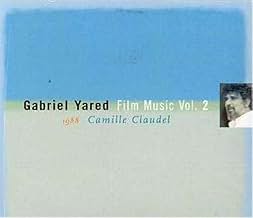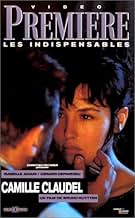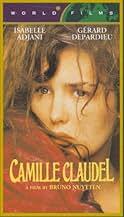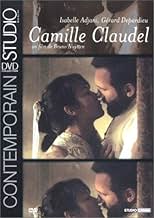AVALIAÇÃO DA IMDb
7,3/10
7,7 mil
SUA AVALIAÇÃO
Camille Claude impressiona o já famoso escultor Auguste Rodin. Ele a contrata como sua assistente, mas logo Camille começa a esculpir-se e também se torna sua amante. Mas depois de um tempo,... Ler tudoCamille Claude impressiona o já famoso escultor Auguste Rodin. Ele a contrata como sua assistente, mas logo Camille começa a esculpir-se e também se torna sua amante. Mas depois de um tempo, ela gostaria de sair da sombra dele.Camille Claude impressiona o já famoso escultor Auguste Rodin. Ele a contrata como sua assistente, mas logo Camille começa a esculpir-se e também se torna sua amante. Mas depois de um tempo, ela gostaria de sair da sombra dele.
- Direção
- Roteiristas
- Artistas
- Indicado a 2 Oscars
- 7 vitórias e 14 indicações no total
Avaliações em destaque
In the realm of art and cinema, there are tales of triumph, stories of struggle, and then there is the heart-wrenching saga of Camille Claudel, masterfully portrayed in Bruno Nuytten's film. This cinematic masterpiece delves into the life of the 19th-century French sculptor Camille Claudel, bringing her intricate story to life with unparalleled grace and depth. It's a tale of passion, creativity, madness, and societal restraint, told through the lens of Camille's artistry.
Camille Claudel, portrayed by the brilliant Isabelle Adjani, was a remarkable sculptor. The film showcases her life journey, from her upbringing in the small village of Villeneuve-sur-Fère to her artistic blossoming in Paris under the guidance of none other than the renowned Auguste Rodin. Their encounter, a passionate rendezvous between student and master, ignites a profound and turbulent love affair.
The film captures the beauty of Camille's artistry as her hands meticulously shape exquisite works of art. Her sculptures are a testament to her modernity, audacity, and unwavering dedication to the craft. They reflect the struggles, the passions, and the relentless pursuit of her artistry, providing glimpses into her inner world. While Camille's works are captivating, her relationship with Rodin brings both admiration and scorn. Their union is a blend of student-mentor dynamics, artistic collaboration, and intense romantic involvement, leading to unrelenting societal judgment.
Yet, Camille is not solely defined by her artistic genius. Her life is marked by isolation, frustration, and the anguish of an unrequited love, intensified by Rodin's continued relationship with Rose Beuret. She becomes an artist alone, adrift in the sea of her emotions. Her world is a whirlpool of despair, loneliness, and financial struggle, interspersed with visions and obsessions that haunt her.
Camille's family disapproves of her lifestyle and choices, and the art world misunderstands her uniqueness. Her mother despises her perceived recklessness, her brother Paul harbors jealousy for her extraordinary talent, and her sister Louise schemes to claim Camille's inheritance. In the face of relentless adversity, Camille is committed to her artistic expression and personal journey.
Despite her distance from Rodin, he continues to support her with discreet acts of kindness. He writes letters to secure precious materials for her work, and he introduces her to influential art critics. However, these critics view her art as unconventional, mirroring her uniqueness and inner turmoil.
Camille Claudel, the artist par excellence, lived a life of wealth, beauty, determination, and promise in her youth. Still, her brilliance was overshadowed by the tragedy of her later years. She was left unrecognized, locked away in isolation, where her art became both her refuge and her torment. It was here, within the confines of her solitude, that she chose to destroy many of her own creations.
Camille's story is a testament to a life of artistry and heartache, unacknowledged talent, and the agony of unrealized dreams. Her impact on the art world was long overdue for recognition. Almost a century later, in 1988, her life's narrative was finally shared with the world through Bruno Nuytten's film, marking a turning point in the rediscovery of her art and her enduring legacy. The Musée Camille Claudel, opened in 2017 in Nogent-sur-Seine, France, stands as a national museum, dedicated to preserving and celebrating her art, ensuring that Camille Claudel's work rightfully finds its place in the annals of art history.
Camille Claudel, portrayed by the brilliant Isabelle Adjani, was a remarkable sculptor. The film showcases her life journey, from her upbringing in the small village of Villeneuve-sur-Fère to her artistic blossoming in Paris under the guidance of none other than the renowned Auguste Rodin. Their encounter, a passionate rendezvous between student and master, ignites a profound and turbulent love affair.
The film captures the beauty of Camille's artistry as her hands meticulously shape exquisite works of art. Her sculptures are a testament to her modernity, audacity, and unwavering dedication to the craft. They reflect the struggles, the passions, and the relentless pursuit of her artistry, providing glimpses into her inner world. While Camille's works are captivating, her relationship with Rodin brings both admiration and scorn. Their union is a blend of student-mentor dynamics, artistic collaboration, and intense romantic involvement, leading to unrelenting societal judgment.
Yet, Camille is not solely defined by her artistic genius. Her life is marked by isolation, frustration, and the anguish of an unrequited love, intensified by Rodin's continued relationship with Rose Beuret. She becomes an artist alone, adrift in the sea of her emotions. Her world is a whirlpool of despair, loneliness, and financial struggle, interspersed with visions and obsessions that haunt her.
Camille's family disapproves of her lifestyle and choices, and the art world misunderstands her uniqueness. Her mother despises her perceived recklessness, her brother Paul harbors jealousy for her extraordinary talent, and her sister Louise schemes to claim Camille's inheritance. In the face of relentless adversity, Camille is committed to her artistic expression and personal journey.
Despite her distance from Rodin, he continues to support her with discreet acts of kindness. He writes letters to secure precious materials for her work, and he introduces her to influential art critics. However, these critics view her art as unconventional, mirroring her uniqueness and inner turmoil.
Camille Claudel, the artist par excellence, lived a life of wealth, beauty, determination, and promise in her youth. Still, her brilliance was overshadowed by the tragedy of her later years. She was left unrecognized, locked away in isolation, where her art became both her refuge and her torment. It was here, within the confines of her solitude, that she chose to destroy many of her own creations.
Camille's story is a testament to a life of artistry and heartache, unacknowledged talent, and the agony of unrealized dreams. Her impact on the art world was long overdue for recognition. Almost a century later, in 1988, her life's narrative was finally shared with the world through Bruno Nuytten's film, marking a turning point in the rediscovery of her art and her enduring legacy. The Musée Camille Claudel, opened in 2017 in Nogent-sur-Seine, France, stands as a national museum, dedicated to preserving and celebrating her art, ensuring that Camille Claudel's work rightfully finds its place in the annals of art history.
A *very* powerful film about a woman and her life. Acting and setup is so good that it can leave permanent scars on your psyche. Hitchcock can scare for a few minutes, while this movie can scare you for life. Do not watch while depressed. I give it a minimum of 8 out of 10. Wonderful job.
This is an excellent film and I highly recommend it. The imagery and soundtrack is lush, and the story focuses intensely on Camille's perfectionism and fortitude, all the while depicting her descent into madness, although some claim she wasn't mad, merely a woman ahead of her time, and thus ostracized.
From what I have read of various biographies of Camille Claudel, I understand that she was a woman ahead of her time; she scorned the bourgeois, just as many artists, writer, and musicians did -- in the same way that modern artists scorn the common, small-minded, and narrow society (read Hermann Hesse's Steppenwolf for a good understanding of the artist's situation in society).
Following the pattern of Vincent van Gogh and Franz Schubert, Camille Claudel was not a great "promoter" of her works, and, to make things worse, the bourgeois society, just like today, failed to understand her art (again, like the plight of Vincent van Gogh and many others).
At her core, Camille Claudel was a true rebel, not because she wanted to be, but because she had to. Camille Claudel was a true artist, in the very deepest sense.
From what I have read of various biographies of Camille Claudel, I understand that she was a woman ahead of her time; she scorned the bourgeois, just as many artists, writer, and musicians did -- in the same way that modern artists scorn the common, small-minded, and narrow society (read Hermann Hesse's Steppenwolf for a good understanding of the artist's situation in society).
Following the pattern of Vincent van Gogh and Franz Schubert, Camille Claudel was not a great "promoter" of her works, and, to make things worse, the bourgeois society, just like today, failed to understand her art (again, like the plight of Vincent van Gogh and many others).
At her core, Camille Claudel was a true rebel, not because she wanted to be, but because she had to. Camille Claudel was a true artist, in the very deepest sense.
An exhibit of Rodin's sculptures was circling the Western United States a few years back. In any gallery in which they were exhibited they snapped heads; there are few figures that speak with such authority or superiority, mute testimony, like the Easter Island figures, to as much effort and skill. And so the movie `Camille Claudel', in like fashion, snaps heads in its understated power and commitment to craft.
Like Ansel Adams, Rodin stretched nature beyond what was possible they both showed us something that was not there and in the rendering made representations so striking they had no precedent and thus set the bar higher for subsequent generations of artists. As history played out, the far less well known sculptor Camille Claudel made substantial contributions but her tie to Rodin (and eventually her personal decline) for a period in the late nineteenth century is the focus in this instance. In truth, her story demanded to be filmed; she stands a remarkable artist and most importantly the passion, talent and influence (inarguably on Rodin) she possessed went well beyond the `colorful' label oft attached to the gifted.
Historically, this film is probably not a bad representation of how events turned in her life. There are many issues and turns, and years for that matter, the details of which remain unclear to this day. But in its entirety this is a marvelous interpretation of the record. And without doubt Isabelle Adjani was the right actor for the job.
Stunningly beautiful, there are few women in history as arresting as Isabelle is; certainly Camille was not as lovely, but the resemblance is darned good as compared to actors chosen to portray historical figures in most movies based on true events and the people that were part of them. That Adjani brings some of the passion is certain. After all, bizarre, or at least socially unacceptable, behavior resulted in her eventual incarceration, so we know she was a handful.
Many of the key points of her upbringing are addressed; her father's stern and inconsistent yet lovingly supportive position in her life (this is more forcefully impressed on us as the years progress); her mother's complete non-support and dismissal of all that Camille does; her relationship with her less understanding and conflicted brother. But it is the period when she meets and falls for Rodin (and he with her) and their consequent tumultuous affair runs its course that is actually the focus of the film.
Gérard Depardieu's contribution as Rodin is probably the best work he has done. He looks (Rodin was 40 when he met the 21 year old Camille) very much as Rodin did in this period of his life. His love for his work, Camille and promoting his own career are his passions. We are lead through the minefield of his own making (his inability to get off a dime and marry Camille is their eventual downfall) and we are not totally sympathetic to his behavior. But this is the stuff of real life; as Seneca said, all art is but imitation of nature and both his and her own work convey their conflicted convictions.
The musical score haunts us, as it should, right from the opening of the film. Almost never detracting, it instead correctly underscores certain points in the narrative; but it is the opening where we see Camille scooping clay from beneath a Parisian street (and this is a well-crafted sequence) where we feel the upsurge of powerful currents operating. The music heightens our interest as we determine exactly what we are seeing.
Other nice touches in the film include an occasion where Camille and Rodin together study a model on a turntable, spinning the model about as metaphor for the emotional maelstrom gathering momentum. We also see a great moment when Rodin is caressing Camille's face, intercut with shots of him working clay into an as yet unidentifiable sculpture.
What follows the breakup of Camille and Rodin is essentially a retrospective of the downslide of a remarkable talent. The story of Claudel's own diminishing output of work and the steady erosion of her inability to cope with reality is frightening in its telling. At a meeting with Rodin some time after they have parted company she remarks that she has changed, and offers that `Nothing that's monstrous is foreign to me'. And so she truly (and sadly) withdraws into a world of her own making.
Rating: Four Stars.
Like Ansel Adams, Rodin stretched nature beyond what was possible they both showed us something that was not there and in the rendering made representations so striking they had no precedent and thus set the bar higher for subsequent generations of artists. As history played out, the far less well known sculptor Camille Claudel made substantial contributions but her tie to Rodin (and eventually her personal decline) for a period in the late nineteenth century is the focus in this instance. In truth, her story demanded to be filmed; she stands a remarkable artist and most importantly the passion, talent and influence (inarguably on Rodin) she possessed went well beyond the `colorful' label oft attached to the gifted.
Historically, this film is probably not a bad representation of how events turned in her life. There are many issues and turns, and years for that matter, the details of which remain unclear to this day. But in its entirety this is a marvelous interpretation of the record. And without doubt Isabelle Adjani was the right actor for the job.
Stunningly beautiful, there are few women in history as arresting as Isabelle is; certainly Camille was not as lovely, but the resemblance is darned good as compared to actors chosen to portray historical figures in most movies based on true events and the people that were part of them. That Adjani brings some of the passion is certain. After all, bizarre, or at least socially unacceptable, behavior resulted in her eventual incarceration, so we know she was a handful.
Many of the key points of her upbringing are addressed; her father's stern and inconsistent yet lovingly supportive position in her life (this is more forcefully impressed on us as the years progress); her mother's complete non-support and dismissal of all that Camille does; her relationship with her less understanding and conflicted brother. But it is the period when she meets and falls for Rodin (and he with her) and their consequent tumultuous affair runs its course that is actually the focus of the film.
Gérard Depardieu's contribution as Rodin is probably the best work he has done. He looks (Rodin was 40 when he met the 21 year old Camille) very much as Rodin did in this period of his life. His love for his work, Camille and promoting his own career are his passions. We are lead through the minefield of his own making (his inability to get off a dime and marry Camille is their eventual downfall) and we are not totally sympathetic to his behavior. But this is the stuff of real life; as Seneca said, all art is but imitation of nature and both his and her own work convey their conflicted convictions.
The musical score haunts us, as it should, right from the opening of the film. Almost never detracting, it instead correctly underscores certain points in the narrative; but it is the opening where we see Camille scooping clay from beneath a Parisian street (and this is a well-crafted sequence) where we feel the upsurge of powerful currents operating. The music heightens our interest as we determine exactly what we are seeing.
Other nice touches in the film include an occasion where Camille and Rodin together study a model on a turntable, spinning the model about as metaphor for the emotional maelstrom gathering momentum. We also see a great moment when Rodin is caressing Camille's face, intercut with shots of him working clay into an as yet unidentifiable sculpture.
What follows the breakup of Camille and Rodin is essentially a retrospective of the downslide of a remarkable talent. The story of Claudel's own diminishing output of work and the steady erosion of her inability to cope with reality is frightening in its telling. At a meeting with Rodin some time after they have parted company she remarks that she has changed, and offers that `Nothing that's monstrous is foreign to me'. And so she truly (and sadly) withdraws into a world of her own making.
Rating: Four Stars.
I couldn't take my eyes away from the television, and it wasn't because it was in French with English subtitles. This is a superbly acted film depicting two artists' work, passion, fears and ultimately her downfall, falling victim to her own creative mind.
Now that this wonderful story will be a Broadway musical in 2003 under the finesse of Frank Wildhorn and the magical voice of lovely Linda Eder, one will certainly appreciate familiarizing themselves with the background of the subject of this movie, Camille Claudel.
Now that this wonderful story will be a Broadway musical in 2003 under the finesse of Frank Wildhorn and the magical voice of lovely Linda Eder, one will certainly appreciate familiarizing themselves with the background of the subject of this movie, Camille Claudel.
Você sabia?
- CuriosidadesAlain Cuny, who plays Camille and Paul Claudel's father, actually met Paul Claudel. In 1944, Claudel, a poet and dramatist, personally chose Cuny to play Pierre de Craon in his play: The Tidings Brought to Mary.
- Citações
Camille Claudel: [to Auguste Rodin] You stole it all! My youth, my work! Everything!
- Versões alternativasThe North American theatrical release was cut to 158 minutes. The Region 1 VHS and DVD releases used this cut print. The full-length 175-minute version is available on Region 2 DVDs released in Europe. The version on Blu-Ray and Amazon Prime Video is 173 minutes, just 2 minutes short of the original European release.
Principais escolhas
Faça login para avaliar e ver a lista de recomendações personalizadas
- How long is Camille Claudel?Fornecido pela Alexa
Detalhes
- Data de lançamento
- País de origem
- Central de atendimento oficial
- Idiomas
- Também conhecido como
- Bir Kadın
- Empresas de produção
- Consulte mais créditos da empresa na IMDbPro
Bilheteria
- Faturamento bruto nos EUA e Canadá
- US$ 3.331.297
- Fim de semana de estreia nos EUA e Canadá
- US$ 89.273
- 25 de dez. de 1989
- Faturamento bruto mundial
- US$ 3.331.892
- Tempo de duração2 horas 55 minutos
- Mixagem de som
- Proporção
- 2.35 : 1
Contribua para esta página
Sugerir uma alteração ou adicionar conteúdo ausente

Principal brecha
By what name was Camille Claudel (1988) officially released in India in English?
Responda
![Assistir a Bande-annonce [OV]](https://m.media-amazon.com/images/M/MV5BOTI2NDAyODUtMzAzZi00OTE4LThlYjItZjYwYjk1OThkMDQwXkEyXkFqcGdeQXRyYW5zY29kZS13b3JrZmxvdw@@._V1_QL75_UX500_CR0)































